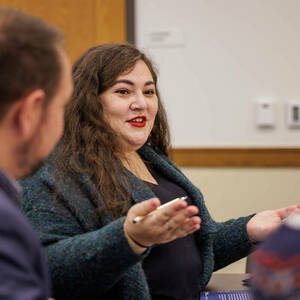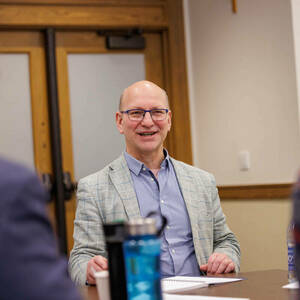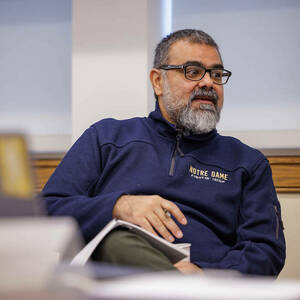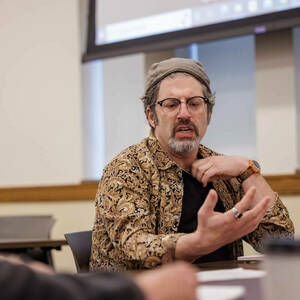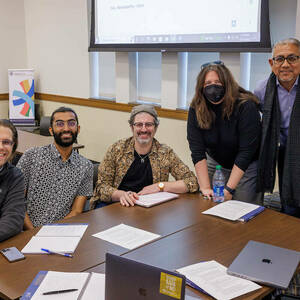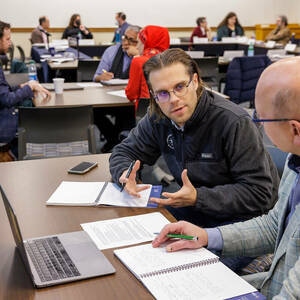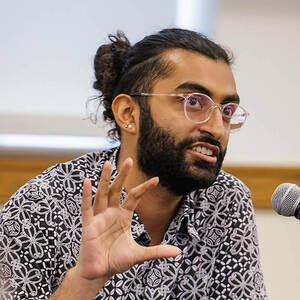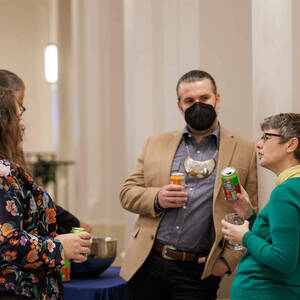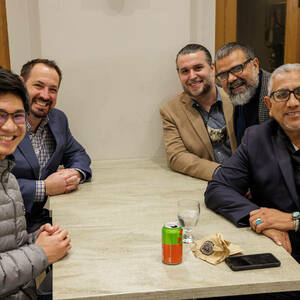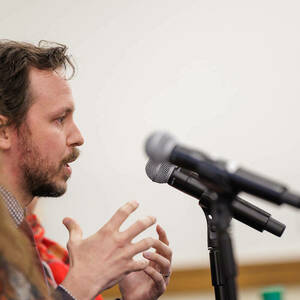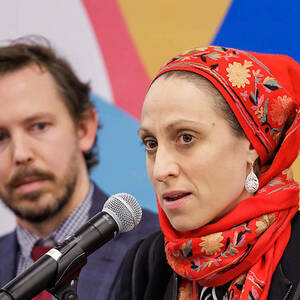Summary
In order to gauge religion’s capacity to reflect upon and bring about the future, our trialogue featured individual participants’ presentations, large-group discussions, and small-group response sessions. We represented three separate but interlinked vocations—journalism, academia, and religion. We wanted to discuss stories about religious hope, promise, progress, and revelation, and concerning religious communities and institutions confronting uncertainty over the long term. Academics contributed historical, theological, and ethical perspectives on their researching and teaching religion; media professionals discussed their craft and constraints in covering the faith beat; and religious leaders expanded on their responsibilities to respond to global news events from their positions of leadership, and to hear and tell the stories of their communities.
Our three days together were loosely thematically linked:
- Day One’s “Imagining Futures” focused on the religious visions of peace- and policymakers from D.C. to Dublin to Standing Rock;
- Day Two’s “Challenging Futures” provided stories of struggle for justice and inclusion against resistant powers; and,
- Day Three’s “Making Futures” explored how the past could be consulted in order to build and communicate stories crucial to humanity’s survival.
Day One
Mahan Mirza set the stage for the workshop: Academic scholars of religion often deplore what they perceive as lack of nuance or sensationalism around religion in headline news; journalists often find academic accounts of religion too abstract or overcomplicated; and faith leaders sometimes find news stories and academic reports about their communities misinformed and condescending. What’s more, each of these three professions is internally riven by partisan political divides. These impasses, he proposed, could be overcome through small-scale trialogues—bringing representatives from our three professions together to identify and build on our commonalities in order to understand more deeply our vocational differences to mutual advantage. The Ansari Institute’s October 2019 conference, Religion Beyond Memes: Enhancing Public Discourse about Faith and Practice, he explained, emphasized the potential of building workshops to pursue shared, working understanding of how our respective professions engage with religion, its varied representations, and the public.
While initiatives like the Faith Angle Forum bring together academics and journalists to discuss religion’s role in public life, and programs like Sacred Writes train scholars to navigate the media landscape in producing public-facing scholarship, we built our workshops to bring faith leaders directly into the conversation. “Faith in the Story” refers both to our shared dedication to keeping authentic and complex stories about religion in the news, and our commitment to the stories we are compelled to tell from our respective vocations. Participants had been asked to distribute news stories they either wrote or wanted to comment on before the workshop; each participant contributed individual analyses, but through sustained conversation the group was able to read deeper into the news.
Kathryn Joyce described “Reporting on the Religious Right” from the ascent of a Catholic “Alt Right” alongside the Trump presidency to the “postliberal crackup” between “integralists” and “national conservatives” after the 2022 midterms. While a “Christian nationalist” utopia remains compelling for conservative intellectuals, politicians, and electorates in the United States and in Europe, the story of how that vision might be actualized, as Joyce tells it, is rife with contention, intrigue, and ambiguity. Andrew DeCort confronted Christian nationalism in an Ethiopian context in his presentation, “Othering and Neighbor-Love: Let Us Mainstream our Moral Vision for a Flourishing Future.” DeCort described how the Abiy Ahmed regime and other bad actors have supercharged religious othering underlying the civil war by drawing on the example of the historically long-lived Orthodox Christian Ethiopian Empire. According to DeCort, young Ethiopia’s religiousness and religious diversity comprise the social fabric; and Jewish, Orthodox, Muslim, and Pentecostal communities’ and faith leaders’ shared emphasis on loving one’s neighbor point to a flourishing future, “neighbor-love” being both the path and the destination.
Roger Childs shared with us “Five Ds, Five Ts and a Portion of RICE – How to Create Religious Media Content You Can Believe In,” his lessons learned over thirty years in producing programs for religious broadcasting in Ireland and the United Kingdom. “Five Ds” (Devotion, Diversity, Disgrace, Drift, and Doubt) enumerate what to cover; “Five Ds” (Treatment, Tone, Talent, Title, and Trust) indicate how to cover it; and “RICE” (Reflect, Interrogate, Celebrate, and Explain) describes programs’ multiple aims in educating their audiences about religion. Childs shared successful stories behind programs he sponsored at RTÉ on Ireland’s evolving Catholic majority and its integration of immigrant and minority faiths.
Our first response session focused on “Our Professions.” Through a set of questions that asked us to identify commonalities, the three professions first broke into three groups according to their professions to discuss the joys and challenges of our respective callings and the callings of the other two groups. We then broke into groups with one academic, journalist, and faith leader each to compare notes and build mutual understanding. Our presentation sessions continued with economist Anthony Annett’s “Why I Wrote Cathonomics,” a book arguing for a rethinking of macroeconomics on the lines of Catholic Social Teaching. For Annett the regnant neoliberal paradigm lacks a role for the natural world as well as a notion of objective good, and sustained reflection on the Catholic tradition’s views on human dignity and the common good can lead us globally to a more democratic, prosperous, and sustainable future. Natalie Avalos, in “Visibilizing Indigenous Ethics and Worldviews,” taught us about American “indigenous futurity” that challenges tropes of the noble savage and apocalyptic ethnocide: revelations emerged at Standing Rock and other sites of struggle for indigenous land stewardship, revelations that the “teleology of domination” implicit to settler colonialism “has sown the seeds of its own undoing,” as well as how a past and future that is shared between indigenous communities will be consulted to permanently change settler society for the better.
Finally, Pete Cajka and Alexander Hsu led a discussion session about two longform New Yorker pieces from 2022 and 2021: Gideon Lewis-Kraus’s profile of philosopher William McAskill as “reluctant prophet” of tech billionaire-friendly Effective Altruism and David Owen’s profile of activist Molly Burhans’s quest to help the Catholic Church map its extensive land-ownings for the sake of sustainability. Cajka and Hsu helped us probe the ethics of the profiled as well as the profilers: why are these visions so powerful, and which powers do they invoke? How can journalism explore and stimulate the conscience? Should journalists still write hagiographies of their subjects? Our first day’s sessions alternatingly conjured visions of either exclusive or pluralist worlds, radical returns to promised lands and re-workings of beneficent rule. The very language of “right or left” or “progressive or reactionary” did not seem to entirely capture the range and quality of visions with which the religious institutions and individuals catch sight of the future.
Day Two
In “Coalition of Coalitions: The Challenge of Covering Religion and Politics in the Modern Era,” Jack Jenkins walked us through the complexity of reporting on the “Religious Left” in the United States. Weaker and less visible than the “Religious Right,” progressive religious coalitions have nonetheless exercised compelling moral force in promoting policies they support across many short-lived campaigns: saving the Affordable Care Act, orchestrating “Moral Mondays” in North Carolina, and protecting the sacred Mauna Kea from development in Hawaii. Kristel Clayville’s “The Rhetorical Function of Religion in Stories of Organ Transplant” contested the “feel-good stories” that newsmedia circulate about organ transplant which serve to underscore the essential goodness of religious medical institutions and self-sacrificial organ donors. Clayville argued that stories could focus instead on how transplant teams make moral decisions about access, value, scientific innovation, and care, so that people of conscience can think through these stories and publicly deliberate over critical political questions about health inequity and organ transplant policies. We continued with our second response session on “How We Tell Stories,” where we spoke within professions about what we thought good teaching, reporting, and faith work look like; and we spoke across professions about how stories are inspired, crafted, authored, and adapted for different purposes. In answering questions about stories’ “hooks,” what inspires stories “besides a deadline,” and “stories that are important for you to tell but that audiences find difficult to hear,” individual participants could begin to reimagine their respective challenges as shared ones.
We continued presentations in the afternoon. Ann Gleig, in “Intersectional Futures for American Buddhism,” described movements for racial and sexual justice in Buddhist communities across the United States. Majority-white sanghas and Buddhist publications are struggling to lift up and listen to the voices of Asian-American and other non-white Buddhists; and journalists and academics have often failed to attend to the experiences of survivors of sexual abuse from Buddhist faith leaders as well as the theologies and organizations that enable them. Nonetheless, collaboration between academics and Buddhists of color, or public scholars and abused Buddhist women, may result in powerful, nuanced accounts that American Buddhist communities could use for accountability and healing. Nikhil Mandalaparthy, in “The Fractured Future of Hinduism in America: Challenging Oppression and Building Progressive Spaces,” spoke about progressive American Hindus’ recent battles against far-right American Hindu nationalist advocacy groups that lend support to increasingly vicious harassment and violence against religious and caste minority groups in Narendra Modi’s India. To counteract these religious ethnonationalist mobilizations of the global Hindu right, Mandalaparthy’s Hindus for Human Rights and its partners give voice to authentically Hindu traditions of nonviolence, pluralism in religious expression, and service to broader community by circulating educational and activist resources that encourage inclusion, resistance, and free thought.
And in his “The Unlikely Journalist: On Giving Voice to the Voiceless and the Search for Truth,” Justin Whitaker recounted his personal journey from academic Buddhist philosopher and successful Buddhist blogger into professional Buddhist journalist with Buddhistdoor Global. Whitaker recommended a model of “solutions journalism” that engages a reader’s capacity for reason, hope, and action as an antidote to more sensationalistic approaches to reporting and opinion about religion. “Buddhist journalism” would focus on very real suffering alongside equally real attempts to alleviate and reckon with it. Finally, Jawaad Abdul Rahman, in “Muslims Reclaiming the Narrative—The Example of Unity Productions Foundation,” shared with us many clips from movies he produced, and the philosophy and collaborative effort behind them. Against depictions of Muslims as simply “villains or victims,” UPF allows charismatic Muslim characters to tell their own stories, trusting that these wondrously diverse expressions of Islam will be evergreen. Throughout the day, participants testified to the challenge of speaking for marginalized members of religious traditions that refuse the rigid categories with which their political antagonists (co-religionist and otherwise) might seek to contain them. Practitioners of both “Ibrahimic” and “dharmic” traditions are contending against futures where the unthinking rehearsal of stereotypes condemn us to cruelty. They are fighting for futures where more honest stories are lived and shared and where everyone has a home.
Day Three
Sarah Ventre’s “Finding Nuance at the End of the World” invited us to embrace the metaphor of “the crossfade” – the technique that DJs and audio engineers use to transition from one audio sample into the next, to “mix without erasing, combine without destroying.” Ventre has found this metaphor inspirational to her own work producing audio journalism about marginalized people of minority religions in liminal zones in the phenomenal project of making their lives meaningful. Tyler Tully’s “Putting Land Back in the Indian Residential School Discussion” urged us all to seriously reckon with the long history of the U.S. government and Christianity’s roles in settler colonial genocide of and land theft from the indigenous peoples of North America – projects that are still ongoing but erased from view today. Descendants of settlers must engage Native people and their stories with humility in order to make substantive dialogue about the future of our common world even imaginable. Shannon Rivers of the Akimel O’otham, in “The Question of Faith: An Indigenous Perspective on How Western Religion Shaped the Lives and Stories of Native People,” spoke honestly about serving as an indigenous spiritual leader and “warrior against colonialism,” sharply criticizing state- and religiously sanctioned systems of racism, inequality, terracide, and militarism. Campaigning against injustice can come at great emotional and physical cost to Rivers personally, but protecting biodiversity, defending Native dignity, and communicating what indigenous people know to be true is his spiritual inheritance and responsibility.
Joshua Rubin, in “The Liberal Jewish Fellowship: Toward a Tribe without Tribalism,” spoke about remaking his Judaism with texts, voices, and people that the “neotraditionalists” choose to ignore and exclude. His prayer book combines liturgy from English, German, and Hebrew sources; his congregation includes Jews of all races, genders, sexualities, and abilities, and any who claim Jewish identity and practice in good faith; his Judaism “is the Judaism of the past in the process of becoming the Judaism of the future.” Finally, Celene Ibrahim’s “Islamic Feminisms and Muslim Women’s Movements: Striving for Nuanced Coverage between Decolonial, Neoconservative, and Islamic Politics” described the delicate balance that Muslim American women educators and activists have to strike in articulating “we’re just like you… but not” to non-Muslim audiences. When the headlines become saturated with Islamic gender politics – in covering the Mahsa Amini protests in Iran, for instance – media professionals, faith leaders, and academics must work together to “desensationalize, but preserve the character” of distinctively Muslim ideas and practices. The final response session featured Mahan Mirza and Alexander Hsu explaining in greater detail the origins of “Faith and the Story” and soliciting feedback for the future of these trialogues. Our third day’s presentations reflected how sustainable religious futures are not built ex-nihilo, but with wisdom and support from longstanding institutions, traditions of thought and ritual from oral and written sources, and promising, new friendships between peers forged through dialogue and being-in-relation.
Celene Ibrahim, Jack Jenkins, Shannon Rivers, and Sarah Ventre led our concluding evening public panel, summarizing what we had learned together. First: our religious and political lives deeply inform one another, often in unexpected ways. Second: our different religious and spiritual traditions call on us to combat hatred and injustice by examining our own consciences, turning to one another, and learning to listen hard. The invaluable contributions of our Native participants reminded us that in order to arrive at a just future, our institutions need to continue to amplify more diverse, critical voices. Finally: we experienced the trialogue as a liminal space where everybody initially felt like an outsider but could come to see themselves as parts of each others’ stories, and we wondered out loud about how to build more intentional spaces and programs where professional truth-tellers can bring their whole selves and leave with stories that can sustain them in their livelihoods.

